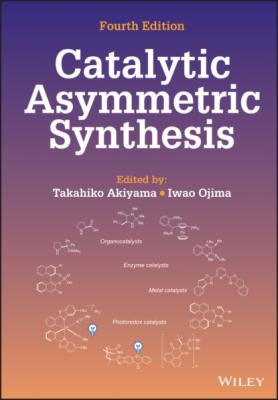Catalytic Asymmetric Synthesis. Группа авторов
Чтение книги онлайн.
Читать онлайн книгу Catalytic Asymmetric Synthesis - Группа авторов страница 30
 also a secondary amine catalyst. These two catalysts are not bifunctional catalysts, and do not possess an acid moiety. Cinchona amine‐based catalysts [10] are prepared from cinchona alkaloids, which are primary amines. This catalyst has several functional groups, and acts as a bifunctional catalyst.
also a secondary amine catalyst. These two catalysts are not bifunctional catalysts, and do not possess an acid moiety. Cinchona amine‐based catalysts [10] are prepared from cinchona alkaloids, which are primary amines. This catalyst has several functional groups, and acts as a bifunctional catalyst.
Figure 1.1. Representative organocatalysts.
Figure 1.2. The reaction of enamines generated from diphenylprolinol silyl ether and proline.
The design concepts underlying bifunctional and monofunctional organocatalysts are different. Diphenylprolinol silyl ether, a monofunctional catalyst, reacts with an aldehyde to generate an enamine, in which one of the enantiofaces of the enamine is completely shielded by the bulky diphenyltrimethylsiloxymethyl moiety, and an electrophile approaches from the opposite side of this bulky substituent (Figure 1.2). Thus, the steric shielding of one of the enantiofaces is a key for the high enantioselectivity. Irrespective of the electrophile, high enantioselectivity is expected because the enantioface selectivity of the nucleophile is controlled by the catalyst. This is a contrast to bifunctional catalysts such as proline, in which an acid moiety activates the electrophile. Thus, the most suitable catalyst for a given reaction depends on the electrophile.
1.2.2. Reactivity of Diphenylprolinol Silyl Ether Catalyst and MacMillan’s Catalyst
Diphenylprolinol silyl ether catalyst and MacMillan’s catalyst are widely used in reactions involving enamine or iminium ion intermediates. In this section, the reactivity of these catalysts will be discussed.
Mayr investigated the nucleophilicity (N) of enamines, and the electrophilicity (E) of iminium ions of several pyrrolidines and imidazolidinones (Figure 1.3) [11]. For enamines, the nucleophilicity is evaluated by the reaction with diarylcarbenium ions, and it correlates poorly with the Brønsted basicities. The enamine, which is derived from diphenylprolinol silyl ether catalyst 2, is almost two orders of magnitude less reactive than the corresponding enamine prepared from pyrrolidine. The reduction of the reactivity is primarily due to the electron‐withdrawing inductive effect of the trimethylsiloxybenzhydryl group in diphenylprolinol silyl ether catalyst. The reactivity of the enamine generated from MacMillan’s catalyst 1 is another two to three orders of magnitude less reactive relative to the enamine of diphenylprolinol silyl ether catalyst, because of the inductive electron‐withdrawing effect of the extra endocyclic amide group in the catalyst, the pyramidalization of the enamine nitrogen, and the steric shielding of both faces of the C=C bond by the two alkyl groups at the 2‐position of the imidazolidinone ring.
In the case of iminium ions, the iminium ion generated from diphenylprolinol silyl ether is 20 times more electrophilic than the iminium ion derived from the parent pyrrolidine because of the electron‐withdrawing substituents. The iminium ion of MacMillan’s catalyst, which is useful for the Diels‐Alder reaction, is more reactive than the iminium ion derived from diphenylprolinol silyl ether.
These investigations indicate that MacMillan’s catalyst is more electron deficient, and that its iminium ion is reactive because of the lower LUMO level. Diphenylprolinol silyl ether catalyst possesses suitable nucleophilicity and electrophilicity of its enamine and its iminium ion, respectively. Thus, this catalyst is effective for domino reactions (see Figure 1.3).
Figure 1.3. Nucleophilicity and electrophilicity of enamines and iminium ions.
Source: Based on [11].
1.2.3. Cinchona Amine‐Based Catalysts
Some secondary amine catalysts, such as diphenylprolinol silyl ether, are effective catalysts in Michael reactions using an aldehyde as a Michael donor (see Scheme 1.1), but these catalysts are not effective in Michael reactions using a ketone as a Michael donor because generation of an enamine from a ketone using diphenylprolinol silyl ether is hindered by its steric bulk. On the other hand, a primary amine can easily generate an enamine from a ketone. Primary amine catalysts derived from cinchona alkaloids have enabled the stereoselective functionalization of a variety of sterically hindered carbonyl compounds, which cannot be realized by secondary amine catalysts (Scheme 1.1) [10]. Moreover, primary amine catalysts can activate structurally substituted substrates such as α‐branched substituted aldehydes and ketones. They also activate α‐substituted α,β‐unsaturated aldehydes and ketones. The reactions of these substrates using chiral cyclic secondary amine catalysts are difficult.
Scheme 1.1. Reactions of cinchona alkaloid catalysts.
Source: Based on [10].
Cinchona alkaloid catalysts act as efficient bifunctional catalysts. They possess a primary amine moiety that can react with aldehydes, ketones, and α,β‐unsaturated carbonyl compounds to generate enamines and imines. The catalysts have a basic quinuclidine moiety, which acts as a base, and a hydroxy or alkoxy group on C9, which can make a hydrogen‐bonding interaction. Thus, they can simultaneously activate both electrophilic and nucleophilic reagents in a reaction.
1.3. ENAMINE
1.3.1. Aldol Reaction
Aldol reaction is one of the most important carbon–carbon bond‐forming reactions in synthetic organic chemistry, and the application of organocatalysts in this reaction has been investigated intensively [12]. The basic design of catalysts for aldol reactions is a bifunctional catalyst such as proline, with acid and basic moieties (Figure 1.4) [13]. The amine moiety reacts with a carbonyl group to generate an enamine, while the acid moiety activates the electrophile. Based on this concept, many bifunctional aldol catalysts have been developed.
Although proline is an effective and inexpensive organocatalyst, its solubility in organic solvents is poor; rather large loading of the catalyst is necessary, and applicable aldol reactions are limited. This has driven the development of organocatalysts that are more reactive and selective than proline, and the substrate scope has been expanded greatly. These developments have been nicely summarized in several reviews [12].
In the proline‐mediated aldol reactions, the anti‐isomer was obtained predominantly, which is explained by List–Houk model (Figure